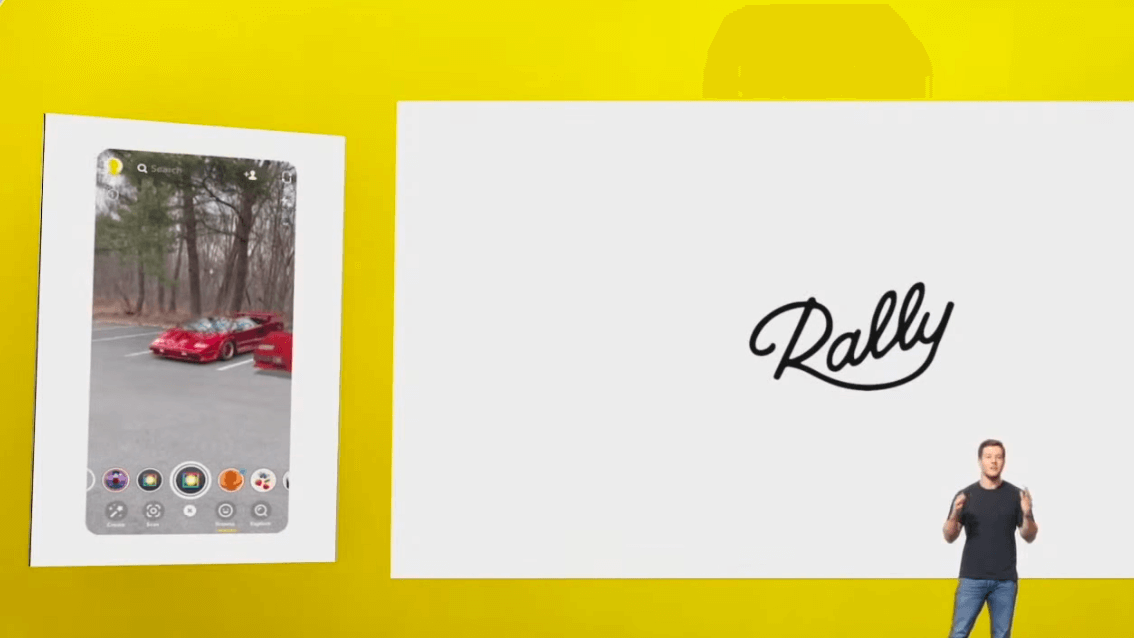Like most recent events, this year’s Snapchat Summit was adapted virtually as opposed to existing in a physical space; it might seem like a no-brainer for a company whose expertise is in the digital realm—but if anything, this year’s summit has proven Snapchat’s ambition of bridging the gap between between augmented reality, and reality.
If the theme of Snapchat up until now has been “show, don’t tell” the mantra they’ve adopted moving forward seems to be “experience, don’t show”. What this means for brands is that Snapchat has uniquely positioned itself to allow artists & studios to create unique, branded AR experiences that transcend the digital sphere.
Below I’ve highlighted the features that I’m most excited about, as well as how they can be utilized to elevate users’ AR experiences.
Local Lenses:
These dynamic lenses use real-life locations (whole areas or specific buildings) to create a unified AR experience that different Snapchatters can share, as long as they’re in the same physical space—the first of its kind. In the example above, multiple people are creating a mural of different colors on one shared space using multiple phones. This added expertiental element creates a unified experience that exists wholly online, but that facilitates physical community. This is the first best of both worlds experience.
 Photo courtesy of Snapchat.
Photo courtesy of Snapchat.
Snap Scan & Marker Lenses:
Scan Partners is a powerful tool for brands. It allows the camera to recognize an item and then attaches it to a specific lens. The examples Snapchat used were a plant-identifer that, when clicked, would provide information on how to care for that plant (including links to buy those items). But they can also be utilized by luxury brands in order to create beautiful AR experiences in the physical world, once again blending the 2. Louis Vuitton recently added their logo as a marker lens, which means that when their logo is scanned in real life in Snapchat, a virtual door to their latest showroom opens highlighting classic and current collections in a virtual showroom. Too-Faced marked their ‘Born This Way’ product packaging—so when scanned, users can try it on virtually. Marker lenses elimiate the need to advertise via Snapcode, as well—the product is the Snapcode.

Photo courtesy of Snapchat.
SnapML:
The developer tool now features SnapM (or Snapchat Machine Learning), which lets developers bring their own machine-learning models to power Snap lenses, making what is possible to create limited only to the imagination. This allows for the creation of lenses that were previously impossible (such as the Van Gogh filter below, created by Nicholas Dominici) that would benefit anything from a new movie or video game with a singular aesthetic, to a museum wanting to highlight a current exhibition.
Additionally, this allows the creation of extremely accurate tracking of faces, gestures, feet, and even landmarks such as buildings. Below, you can see the practical application that Wannaby has used: they created a try-it-on filter that lets users see their newest shoe in a variety of colors (yes, that shoe is AR, not real).
In short, SnapML has destroyed many creative boundaries that previously existed—the new “brand experience” is limited (mostly) by what you can imagine vs by technology, as used to be the case.
 Photo courtesy of Snapchat.
Photo courtesy of Snapchat.
Places:
Snapchat is making it easier than ever to integrate call-to-actions with their app and lenses. One example of this is “Places”, which would lead to an outside-Snap call to action such as ordering a physical product online, whether it’s that new lipstick or food from their favorite delivery spot! This would be especially crucial for smaller businesses that need to receive local support.
 Photo courtesy of Snapchat.
Photo courtesy of Snapchat.
Integration SnapKits:
If your brand has an existing app, Snapchat will now let you integrate their technology with it in order to create a new layer of interaction with your fans. This is more abstract in thought, but can be applicable to any number of brands across any discipline—it’s an equally powerful tool both for those brands within the entertainment industry, and outside of it. Rally Road is an app that is meant for classic car investments, but has integrated Snapchat’s CreativeKit to let users purchase shares in rare items and share them with their friends in a unique AR environment. Atom movie tickets has also utilized this to let its users browse movies, purchase tickets, and choose seats together in one easy experience. There are numerous types of kits available, each with their own unique perks (AdKit, which makes monetizing apps easy with SnapAds, CreativeKit, which allows apps to bring real-time data into Snapchat, and CameraKit, which brings the power os Snapchat camera to your apps).
 Photo courtesy of Snapchat.
Photo courtesy of Snapchat.
Where Do I Start?
If you’re interested leveraging Snapchat for Any of the above uses, a qualified creative studio is your best bet, since we know the ins-and-outs of not only best creative practices to create an attractive filter, but can also help determine which strategy is the way to go when the options can seem endless and equally appealing (especially after this year’s summit).
We here at Bare Tree Media would love to collaborate with any artist, strategist, or brand who’s just as pumped about these new Snapchat features as we are! You can take a look to see the lenses we’ve already created.
